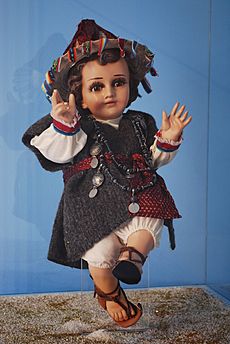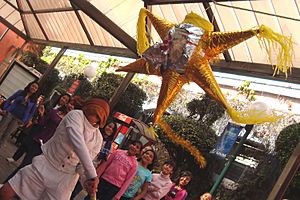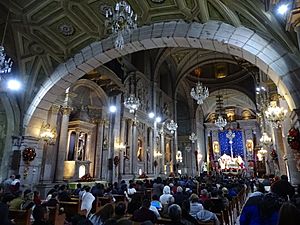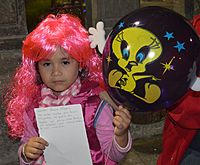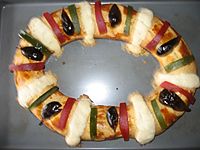Christmas in Mexico facts for kids
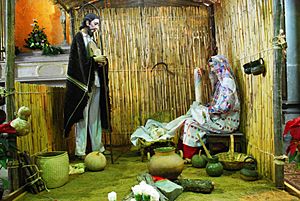

Christmas in Mexico is a special time that lasts from December 12 to January 6. There is even one more celebration on February 2. During this holiday, people use many traditional decorations. These include nativity scenes, beautiful poinsettia flowers, and Christmas trees. The Christmas season starts with celebrations for the Virgin of Guadalupe. She is the Patroness of Mexico. After that, people enjoy traditions like Las Posadas and Pastorelas.
On Christmas Eve, families attend a special church service and have a big feast. On January 6, Mexicans celebrate the arrival of the Three Wise Men. This day is also connected to Candlemas and bringing baby Jesus figures to churches. These traditions mix old customs from before the Spanish arrived with new ones from Mexico's colonial period. This means they combine both native and Spanish ways. Some ideas also come from Germany and the United States.
Contents
Christmas Season in Mexico
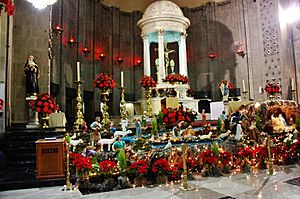
The Christmas season in Mexico runs from December 12 to January 6. There is also a final celebration on February 1. Mexican Christmas traditions mix old native customs, Spanish traditions, new Mexican ideas from colonial times, and even some things from the United States and Germany.
Markets get busy in late November. Both old-style markets and new street markets, called Tianguis, open up. Stalls sell gifts and decorations. You can find traditional poinsettias and nativity scenes. They also sell Christmas trees, ornaments, electric lights, and reindeer figures.
In December, homes and buildings are decorated with poinsettias. These flowers are called "Noche Buena" in Mexico. This means "good night" and refers to Christmas Eve. Long ago, before the Spanish came, these flowers were called "Cuetlaxochitl." They were special in mid-winter. Native people thought they were a sign of fallen warriors getting new life. They believed these warriors returned as hummingbirds to drink the flowers' nectar. A modern Mexican story says the poinsettia was once a simple weed. It magically turned into a beautiful flower. This happened so a child could give it to baby Jesus. The name "Noche Buena" is also used for a special dark beer. This beer is only sold during the Christmas season.
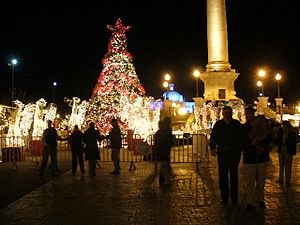
Since the mid-1900s, Mexico has adopted some German and U.S. Christmas traditions. Christmas trees first came to Mexico for people from other countries. But now, they are very popular with Mexican families. Often, a Christmas tree is placed next to a traditional nativity scene. More families have Christmas trees as incomes grow and prices drop. You can easily buy artificial trees at stores like Walmart and Costco. Live trees are also common. Growing Christmas trees in Mexico is now a big business. Families who cannot afford live trees often use small artificial ones, branches, or shrubs.
In 2009, Mexico had the world's largest Christmas tree. It was 110.35 meters (about 362 feet) tall. It weighed 330 tons. This giant tree was on Glorieta de la Palma in Paseo de la Reforma. Santa Claus also appears in his traditional red suit. Before Christmas Day, you can often see stands with Santa Claus. Parents take their kids to these stands for fun photos. After Christmas Day, these stands have one or more "Wise Men."
Many children get gifts from both Santa Claus and the Wise Men. They usually get more from the Wise Men because "there are three of them." Public Christmas parties mix Mexican and foreign traditions. Mexico City has a big Christmas display in its main square, the Zocalo. It has a huge Christmas tree and an ice rink. Nativity scenes are also placed here and along Paseo de la Reforma.
During Christmas, you can hear both old and new Christmas music. Traditional music includes villancicos (like Christmas carols). Popular songs are "Los pastores a Belén," "Riu, riu, chiu: El lobo rabioso," and "Los peces en el río." Newer music includes Spanish versions of foreign songs, like "Jingle Bells."
Nativity Scenes
The most important Christmas decoration is the nativity scene. People usually set it up by December 12. It stays on display until February 2. You can find them in homes and churches. Nativity scenes came to Mexico early in the colonial period. The first Mexican monks taught native people how to carve the figures. The basic setup is like other parts of the world. It focuses on the Holy Family, with angels, shepherds, and animals around them. The figures are placed under a shelter. This can look like a cave, a stone house, or a cabin. Above the scene, there is a star, often with LED lights.
Since colonial times, Mexican touches have been added. People use Spanish moss to cover the base. The figure of Child Jesus is missing until Christmas Eve. All other figures are usually the right size for the scene. But the baby Jesus figure is much larger, almost like a life-sized baby. This figure is central to the nativity scene. It is also important for a tradition on February 2. On this day, people bring the figure to church to be blessed.
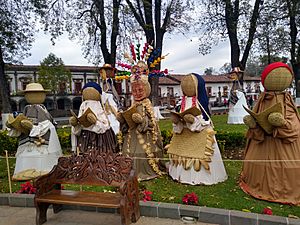
Traditional figures are made from ceramic or plaster. One area famous for making ceramic nativity figures is Guadalajara. Especially the towns of Tonalá and Tlaquepaque. From late November to December, the Tonalá market has many stalls. They sell only supplies for nativity scenes. Besides the usual figures, Mexican nativity scenes have unique ones. These include native Mexican plants and animals, like nopal cacti and turkeys. You might see women making tortillas, fish in a river (from a popular carol), or a crowing rooster (for Christmas Eve). Some even hide figures of Lucifer in the shadows. This is a nod to the pastorelas plays.
Nativity scenes come in all sizes and styles. Large ones can be very detailed. They might have many landscapes and even tiny villages. These usually start with a base of sturdy brown paper. It is crumpled to look like hills and valleys. Sometimes, multi-level bases are used. On top of this base, people use moss, sawdust, sand, colored paper, and paint. They create deserts, grasslands, rivers, and lakes. Then, many structures and figures are added. These can include houses, churches, wells, vendors with fruit carts, playing children, musicians, dancers, and people cooking. All these surround the central Holy Family. The nativity scene at the main church in Chapala has even included things from all over the world. Things like wooden shoes, an igloo, African figures, and exotic animals.
Pastorela
Pastorelas are plays that mean "shepherds' plays." Both amateur and professional groups perform them during Christmas. The first pastorela in the Americas happened in the early 1700s. This was when the first Spanish missions were set up. These plays helped teach the Christmas story to native people.
The Story of Los Pastores
Los Pastores is a nativity play performed on Christmas Eve. In the play, shepherds meet Archangel Michael for the first time. They begin their journey to meet Jesus. On their way, they meet a hermit. He is the funny character in the play. He often carries crosses made of corn cobs and jokes with the audience. The shepherds and hermit fall asleep. Then, the Devil, also called Luzbel, and his demons try to trick them. They try to lead them to Hell instead of to baby Jesus. The shepherds cannot see the devils. But the hermit has a rosary that lets him see them. The Archangel fights the Devils. He defeats them and sends them back to the underworld. Finally, the shepherds reach Jesus. Everyone joins them in a song to celebrate Jesus' birth.
Performances
Rehearsals for these plays are not always strict. The most important part is for the community to share stories and make memories. The final play is not meant to be perfect. These are not professional shows. The main goal is for the community to come together and tell the story of Jesus. The actors often make up parts of the script as they go. So, the play can be very different each time.
The most traditional pastorelas are found in rural areas. There are many versions of the play. Some focus on Mary and Joseph's trip to Bethlehem. Others show battles between the Archangel Michael and the Devil. Some even include modern ideas.
Feast of the Virgin of Guadalupe
The Christmas season starts with celebrations for the Virgin of Guadalupe. She is Mexico's patron saint. On December 3, a nine-day prayer period called a novena begins for her. It ends on her feast day, December 12. The most important event is a trip to her basilica in Mexico City. People travel there in many ways, from planes to bicycles to walking. Many Mexican Catholics make this trip. For example, hundreds of Japanese Mexican people, who are mostly Catholic, go on this trip in kimonos every year.
The area around the basilica gets crowded on December 11. There are lights, fireworks, and native people dancing. This goes on all night and into the next day. The image of the Virgin Mary is honored all over Mexico. In Oaxaca city, the main event is at Parque Llano on December 11. Small boys dressed as Juan Diego go to church to be blessed. Very early on the 12th, the shrine fills with the singing of Las Mañanitas to the Virgin Mary. This is a midnight concert with many Mexican singers. Special church services are held in the Basilica and in all local churches across Mexico.
Las Posadas
From December 16 to 24, there are special processions and parties called Las Posadas. The word "posada" means "inn." For many children, this is the most exciting part of Christmas. This tradition was started by Spanish missionaries. They used it to teach the Christmas story to native people. It also helped replace old rituals for the god Huitzilopochtli.
Today, Posadas are usually held in rural areas and city neighborhoods. The first part is a procession. The most traditional way is to go out after dark each of the nine evenings from a local church. A girl and boy are chosen to play Mary and Joseph in costumes. Sometimes Mary rides a donkey. The rest of the group carries candles, paper lanterns, or decorated sticks. Often, they carry an empty manger. If no one is dressed as Mary and Joseph, the group usually carries a nativity scene.
Las Posadas helps keep communities close. In one version, the procession arrives at a house and splits into two. One half stays outside and sings a traditional song asking for shelter. The other half sings a reply from inside. The ritual ends with everyone going inside. In another version, the procession goes to three houses singing. Two houses "reject" the group, but the third house accepts them.
The piñata was also used by missionaries to teach Christian beliefs. Children break the traditional star-shaped piñata during the Posadas. Like the procession, the Mexican piñata has a special meaning. The piñata itself represents Satan. It holds all the world's good things, decorated to attract people. It traditionally has seven points. These represent the seven deadly sins. The stick used to break it stands for Christian faith. It defeats evil and releases the "treasure" for everyone.
After breaking piñatas, there is a meal. It usually includes tamales, atole (a warm drink), buñuelos (fried pastries), and a hot drink called ponche. Ponche is made from seasonal fruits like tejocote, guava, plum, mandarin orange, orange, or prune. It is sweetened with piloncillo (a type of brown sugar) and spiced with cinnamon or vanilla. Adults might add rum or tequila. Ponche recipes vary a lot in Mexico. The Colima version often has milk, sugar, orange leaves, vanilla, and grated coconut.
At the end of a posada, guests get a small gift called an aguinaldo. This is usually a package with cookies, dried and fresh fruit, and candy. Then, people sing villancicos (carols). An old tradition is to sing a song to the nativity scene, especially to the newborn Child Jesus.
Christmas Eve and Christmas Day
The last posada happens early on Christmas Eve. After that, there is a late-night church service called the Mass of the Rooster. This tradition started about six years after the Spanish arrived. Father Pedro de Gante began celebrating Christmas with a late-night Mass. The name comes from the belief that a rooster crowed when Christ was born. This celebration became popular with the newly converted native people. It included parts from old celebrations for the Aztec god Huitzilopochtli. These included fireworks, torches, sparklers, plays, food, and dancing.
After the Mass, families have a traditional midnight feast. Popular dishes include bacalao. This is dried cod fish cooked with onions, tomato sauce, and olives. Another dish is revoltijo de romerito. This is a green plant in a mole or pepita sauce, with potatoes and often dried shrimp. The most fancy food used to be a suckling pig. But now, turkey or ham are more common. After dinner, adults drink ponche or cider. Children play with sparklers, called Luces de Belén (Bethlehem lights).
Christmas presents are usually opened right at midnight. The rest of Christmas Day is quiet in Mexico. Families relax and recover from the night's fun. They often eat leftovers from the midnight dinner.
Los Santos Inocentes
December 28 is Mexico's version of April Fools' Day. It is called Los Santos Inocentes (The Sainted Innocents). It was first named to remember the babies killed by King Herod. He did this to try to stop Christ's arrival. People also say that on this day, you can borrow anything and not have to give it back. In the 1800s, people would play elaborate tricks to get others to lend them things. If successful, the prankster would send a note to the lender. It would come with sweets or small toys. The note would say, "Innocent little dove who allowed yourself to be deceived, knowing that on this day, nothing should be lent." This then became a day for general pranks. Even newspapers print fake wild stories on this day. This tradition is now also celebrated online.
New Year's Eve
New Year's Eve also falls during this time. It is celebrated much like in other parts of the world, with a few special traditions. One notable custom is eating twelve grapes quickly. You eat one with each of the twelve chimes of the clock at midnight. This is believed to bring luck for each month of the coming year. Fireworks are common. In very rural areas, people might also fire shots into the air. In some parts of Veracruz, December 31 is a day to honor elderly men. This is called the Fiesta del Hombre Viejo.
Three Kings' Day (Epiphany)
The next big event in the Christmas season is Epiphany. It is called Día de los Tres Reyes Magos (Three Kings' Day). This day celebrates when the Three Wise Men visited Child Jesus and brought him gifts. On the night of January 5, children traditionally leave a shoe by the doorway. This is where the Wise Men are supposed to enter. However, this is not done in all parts of Mexico.
Another way children send their wishes is by sending a note in a helium balloon into the sky. Inside the note, they explain if they have been good or bad that year. They also list the gifts they would like if they are worthy. In the morning, after opening presents, a round sweet bread called a rosca is served. It is baked with dried fruit and tiny figures of the infant Jesus inside. Whoever finds one of these figures in their slice must pay for tamales for Candlemas on February 2. The rosca is served with tamales and atole.
Candlemas
Candlemas is celebrated on February 2. It remembers when Child Jesus was presented at the temple. On this day, people bring their figures of Child Jesus to church to be blessed. These figures are dressed up in fancy clothes. Traditionally, they wear christening gowns. But now, many other costumes have appeared too. Afterwards, tamales and atole are shared. These are bought by the people who found the miniature Jesus figures on January 6.
Regional Christmas Season Traditions
There are different Christmas traditions in various regions of Mexico. In Alvarado and Tlacotalpan, there is the Fiesta Negrohispana. This celebrates African identity in Mexico. It runs from December 16 to the 24th.
In Oaxaca, a big event is the feast day of the state's patroness, the Virgin of Solitude, on December 18. She is honored with parades called calendas. These have floats and costumes. The traditional food for this day is buñuelos, a fried pastry covered in sugar. In coastal areas, her image is often brought to shore by boat. Other boats with brass bands accompany it.
In Oaxaca city, on December 23, there is a unique event. It is called La Noche de los Rabanos (Night of the Radishes). People carve oversized radishes into detailed figures. Originally, these were for nativity scenes. But today, there is a big competition. Vegetables are carved into all kinds of figures.
In the Xochimilco area of Mexico City, January 6 is important. It is the day the most famous Child Jesus figure, the Niñopa, changes "hosts." This means a new family takes care of the over 400-year-old figure for the year. In the Nativitas section of the area, there is a parade of the Wise Men. Sometimes, real camels are part of it.
See also
 In Spanish: Navidad en México para niños
In Spanish: Navidad en México para niños
- Culture of Mexico
- Religion in Mexico
- Public holidays in Mexico
- Mexican Christmas dishes


